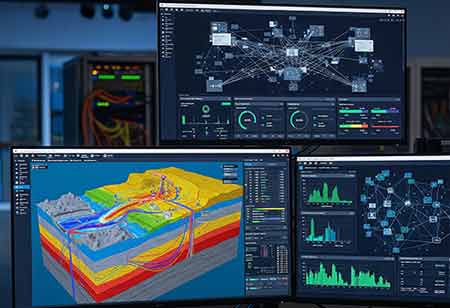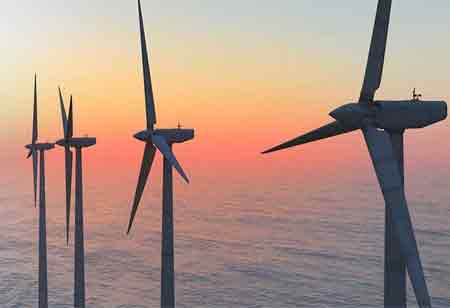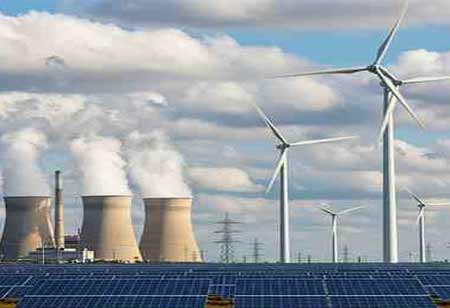CLOSE
Specials
I agree We use cookies on this website to enhance your user experience. By clicking any link on this page you are giving your consent for us to set cookies. More info
Be first to read the latest tech news, Industry Leader's Insights, and CIO interviews of medium and large enterprises exclusively from Energy Tech Review
Thank you for Subscribing
Harnessing Integrated Platforms for Sustainable Oilfield Operations
The oil and gas industry is transitioning from fragmented data silos to integrated modeling platforms, enhancing collaboration, optimizing resource recovery, and accelerating decision-making through real-time insights.

By
Energy Tech Review | Friday, August 22, 2025
Stay ahead of the industry with exclusive feature stories on the top companies, expert insights and the latest news delivered straight to your inbox. Subscribe today.
The oil and gas industry, a vanguard in leveraging data to resolve intricate geological challenges, has maintained data compartmentalized within distinct disciplinary domains. Geologists, reservoir engineers, production technologists, and facilities managers each operated within their specialized software environments, thereby establishing a landscape of digital fragmentation. This disaggregated methodology, characterized by data silos and sequential, unwieldy workflows, is currently being supplanted by an innovative and transformative paradigm: the integrated modeling platform. This foundational transition from disparate data points to comprehensive digital collaboration is fundamentally altering the comprehension, development, and optimization of assets throughout their entire lifecycle.
A linear, sequential approach characterized the conventional workflow. A geological model would be constructed, subsequently transferred to a reservoir engineer for dynamic simulation. The output from this simulation—production profiles—would then be transmitted to production and facilities engineers for the design of requisite wells, pipelines, and processing equipment. Each transfer represented a potential source of delay, data loss, and misinterpretation. Models were static representations at a given point in time, and their updating with new information constituted a laborious process that could span weeks or months. This inherent latency implied that by the time a decision was rendered, the foundational data might already be obsolete, leading to suboptimal field development plans and reactive operational strategies. The inability to perceive the comprehensive picture—from the pore space within the rock to the export pipeline—generated considerable hidden inefficiencies and obscured opportunities for holistic optimization.
The Dawn of a Unified Digital Ecosystem
The catalyst for change has been a confluence of technological advancement and an unrelenting drive for greater efficiency. The proliferation of sensors throughout the oilfield, from downhole gauges to surface equipment monitors, has created a data deluge. Simultaneously, the maturation of cloud computing has provided the scalable, on-demand computational power necessary to process this information. It is within this new context that integrated modeling platforms have emerged.
These platforms represent a quantum leap beyond simple data storage. They are sophisticated digital ecosystems designed to create a single source of truth for an entire asset. By ingesting and standardizing data from every discipline—seismic surveys, well logs, core samples, production rates, pressure readings, and equipment performance—they break down the walls between silos. The core principle is interoperability, where models from different domains are no longer isolated but are linked. A change in geological interpretation can automatically propagate through the reservoir simulation, recalculating production forecasts and assessing the impact on surface facility constraints, all within a unified environment. This creates a living, breathing digital representation of the physical asset, often referred to as a "digital twin."
Unlocking Value Through Holistic Insight
The primary value of an integrated platform lies in its ability to provide a comprehensive, end-to-end view of the production system. This holistic perspective enables a level of analysis and optimization that was previously unattainable. Instead of optimizing the reservoir in isolation, teams can now perform system-wide optimization, balancing subsurface performance with surface network capacity and economic drivers. This allows operators to answer complex, interdependent questions in near real-time: How will drilling a new well in one part of the field affect production from existing wells? What is the most energy-efficient way to route fluids through the pipeline network to meet processing targets? How does subsurface uncertainty impact the net present value of the entire project?
This capability fundamentally accelerates the decision-making cycle. Complex "what-if" scenarios that once took months of painstaking, manual data transfer and model recalibration can now be evaluated in a matter of hours. Engineers and geoscientists can collaboratively explore a much wider range of development concepts, leading to more robust and profitable field development plans. The integration of artificial intelligence and machine learning algorithms into these platforms further amplifies their power. AI can sift through vast datasets to identify subtle patterns, predict equipment failures before they occur, and recommend optimal operational settings, moving the industry from a reactive to a proactive and predictive stance.
A New Collaborative and Evergreen Future
Beyond the technological mechanics, integrated platforms are fostering a profound cultural shift. By providing a shared space where all disciplines can view and interact with the same data and models, they are dismantling long-standing departmental barriers and encouraging true cross-functional collaboration. A geologist can immediately see how their structural interpretation impacts the production engineer's well performance model, leading to a richer, shared understanding of the asset.
The architecture of these modern platforms, often built on open, cloud-native standards, ensures they are not closed systems. They are designed to be extensible, allowing for the integration of third-party applications and novel algorithms, which fosters continuous innovation. This leads to the concept of the "evergreen" model—a digital twin that is perpetually updated with real-time operational data, constantly learning and refining its accuracy. This living model becomes the central nervous system for the asset, guiding everything from long-term strategic planning to minute-by-minute operational adjustments.
The transition from disparate data silos to cohesive, integrated platforms represents a strategic evolution rather than a mere IT upgrade. This shift signifies the digitalization of knowledge and the automation of insights. By consolidating data, models, and personnel, these platforms enable oil and gas operators to optimize resource recovery, enhance operational efficiency, and facilitate more rapid and informed decision-making within an increasingly intricate energy landscape.

Copyright © 2025 Energy Tech Review. All rights reserved






